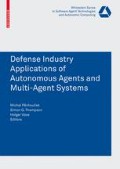Abstract
The DEFACTO system is a multi-agent based tool for training incident commanders for large scale disasters. While this system is currently used for the command of a disaster response scenario, the lessons learned and the methods used to approach this challenging domain apply directly to military applications such as the command and control of troops. In this paper, we highlight some of the lessons that we have learned from our interaction with the Los Angeles Fire Department (LAFD) and how they have affected the way that we continued the design of our training system. These lessons were gleaned from LAFD feedback and initial training exercises and they include: system design, visualization, improving trainee situational awareness, adjusting training level of difficulty and situation scale. We have taken these lessons and used them to improve the DEFACTO system’s training capabilities. We have conducted initial training exercises to illustrate the utility of the system in terms of providing useful feedback to the trainee.
This research was supported by the United States Department of Homeland Security through the Center for Risk and Economic Analysis of Terrorism Events (CREATE) under grant number N00014-05-0630. However, any opinions, findings, and conclusions or recommendations in this document are those of the authors and do not necessarily reflect views of the United States Department of Homeland Security.
Access this chapter
Tax calculation will be finalised at checkout
Purchases are for personal use only
Preview
Unable to display preview. Download preview PDF.
References
J. W. Baxter and G. S. Horn, “Controlling teams of uninhabited air vehicles,” in Proceedings of the fourth international joint conference on Autonomous agents and multiagent systems (AAMAS), 2005.
S. Karim and C. Heinze, “Experiences with the design and implementation of an agent-based autonomous uav controller,” in Proceedings of the fourth international joint conference on Autonomous agents and multiagent systems (AAMAS), 2005.
H. Kitano, S. Tadokoro, I. Noda, H. Matsubara, T. Takahashi, A. Shinjoh, and S. Shimada, “Robocup rescue: Search and rescue in large-scale disasters as a domain for autonomous agents research,” in IEEE SMC, volume VI, pages 739–743, Tokyo, October 1999.
L. L. N. Laboratory, “Jcats-joint conflict and tactical simulation,” in http://www.jfcom.mil/about/fact jcats.htm, 2005.
D. V. Pynadath and M. Tambe, “Automated teamwork among heterogeneous software agents and humans,” Journal of Autonomous Agents and Multi-Agent Systems (JAAMAS), 7:71–100, 2003.
P. Scerri, D. Pynadath, and M. Tambe, “Towards adjustable autonomy for the real world,” Journal of Artificial Intelligence Research, 17:171–228, 2002.
P. Scerri, D. V. Pynadath, L. Johnson, P. Rosenbloom, N. Schurr, M. Si, and M. Tambe, “A prototype infrastructure for distributed robot-agent-person teams,” In AAMAS, 2003.
N. Schurr, J. Marecki, P. Scerri, J. P. Lewis, and M. Tambe, “The defacto system: Training tool for incident commanders,” In The Seventeenth Innovative Applications of Artificial Intelligence Conference (IAAI), 2005.
A. S. Technology, “Epics-emergency preparedness incident commander simulation,” In http://epics.astcorp.com, 2005.
W. A. van Doesburg, A. Heuvelink, and E. L. van den Broek, “Tacop: A cognitive agent for a naval training simulation environment,” in Proceedings of the fourth international joint conference on Autonomous agents and multiagent systems (AAMAS), 2005.
Author information
Authors and Affiliations
Editor information
Editors and Affiliations
Rights and permissions
Copyright information
© 2007 Birkhäuser Verlag Basel/Switzerland
About this chapter
Cite this chapter
Schurr, N., Tambe, M. (2007). Using Multi-Agent Teams to Improve the Training of Incident Commanders. In: Pěchouček, M., Thompson, S.G., Voos, H. (eds) Defence Industry Applications of Autonomous Agents and Multi-Agent Systems. Whitestein Series in Software Agent Technologies and Autonomic Computing. Birkhäuser Basel. https://doi.org/10.1007/978-3-7643-8571-2_9
Download citation
DOI: https://doi.org/10.1007/978-3-7643-8571-2_9
Publisher Name: Birkhäuser Basel
Print ISBN: 978-3-7643-8570-5
Online ISBN: 978-3-7643-8571-2
eBook Packages: Computer ScienceComputer Science (R0)

